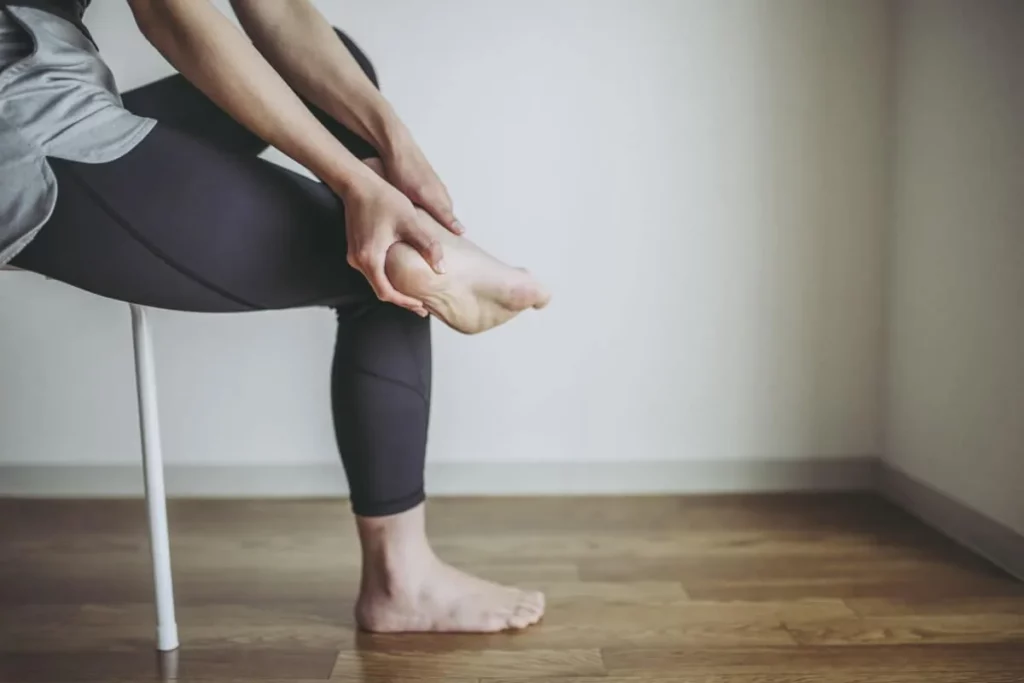If you’ve ever suffered an ankle sprain, you know how debilitating it can be. Ankle sprains are one of the most common injuries, and they can occur in any setting – from sports to everyday activities. In this blog post, we will discuss some tips from orthopedic surgeons on how to prevent ankle sprains. Keep reading for helpful advice on how to stay safe and injury-free!
Contents
What Are Ankle Sprains?
 An ankle sprain is an injury to the ligaments in the ankle. Ligaments are strong bands of tissue that connect bones to other bones. A sprain occurs when the ligaments are stretched or torn.
An ankle sprain is an injury to the ligaments in the ankle. Ligaments are strong bands of tissue that connect bones to other bones. A sprain occurs when the ligaments are stretched or torn.
Most ankle sprains occur when the foot turns inward (inversion injury). This type of injury usually happens when you land on the outside of your foot after a fall or when your foot hits an object, such as a curb. Ankle sprains can also occur when the foot turns outward (eversion injury). This type of sprain is less common and usually happens when you land on the inside of your foot.
This condition can be characterized by several different grades, depending on the severity of the injury:
- Grade I: A mild stretching of the ligament with no joint instability.
- Grade II: A partial tear of the ligament with some joint instability.
- Grade III: A complete rupture of the ligament with severe joint instability.
It is important to understand that a Grade III ankle sprain is a serious injury that requires prompt medical attention. Let’s further discuss how to prevent ankle sprains because even a Grade I sprain can be painful and lead to long-term problems.
How To Prevent Ankle Sprains?
Well, prevention is an essential step in order to avoid this condition. Here are some tips that might help you:
Warm-up before exercise
It is always important to warm up your muscles and joints before any strenuous activity. A good warm-up will increase the temperature of your muscles, making them more flexible and less likely to sustain an injury. For example, you can do some light aerobic exercises or take a short walk before playing sports. because if you don’t, your risk of developing a sprain increases.
Wear proper footwear
Make sure to wear shoes that fit well and provide adequate support for your feet. This is especially important if you are participating in activities that put a lot of stress on your feet and ankles, such as running or basketball. It is believed that a proper pair of shoes can help to absorb some of the impacts and reduce the risk of a sprain. For example, choose shoes with good cushioning and support.
Avoid high-risk activities
Some activities are simply more dangerous than others when it comes to ankle sprains. For example, contact sports that involve stopping and starting quickly, or changing direction rapidly, such as soccer, football, and basketball, are more likely to lead to ankle sprains. If you participate in these activities, be sure to wear proper ankle support and take other precautions to reduce your risk.
Stretch regularly
 Stretching helps to lengthen your muscles and tendons, making them less prone to injury. It is best to stretch after a warm-up. Hold each stretch for at least 30 seconds and repeat the stretch 2-3 times. There are even some great apps out there that can help you with your stretching routine!
Stretching helps to lengthen your muscles and tendons, making them less prone to injury. It is best to stretch after a warm-up. Hold each stretch for at least 30 seconds and repeat the stretch 2-3 times. There are even some great apps out there that can help you with your stretching routine!
In addition, some easy stretching exercises that you can choose to do every day include:
- Heel drops: Stand on a step with your heels hanging off the edge. Slowly lower your heels as far as possible and then raise them back up. Repeat this 15 times.
- Toe raises: Sit in a chair with your feet flat on the floor. Slowly raise your toes as high as possible and hold for 5 seconds. Then lower them back down and repeat 10 times.
- Calf stretches: Put your hands on a wall and step forward with one leg. Keeping your back leg straight, lean into the wall until you feel a stretch in your calf. Hold for 30 seconds and repeat on the other side.
Stay in shape and don’t overdo it
It is important to stay in good physical shape and have strong muscles in order to prevent ankle sprains. This means regular exercise and not overdoing it when playing sports or working out. Because if you’re in shape and have strong muscles, your body is better able to handle the impact and stress that can lead to a sprain.
Be careful on uneven surfaces
Sometimes, ankle sprains happen simply because you step on something uneven. Whether you’re walking on gravel or running on a hill, it’s important to be aware of changes in elevation and terrain. Be particularly careful when wearing high heels, which can make it difficult to judge changes in surface level. Because this is not an exhaustive list, if you have any doubts about a surface, it is always best to err on the side of caution and avoid it.
Consider RICE method
If you have a sprain, you may have heard of the RICE method:
- Rest: Avoid activity that caused the injury.
- Ice: Apply ice to the injured ankle for 20 minutes at a time, several times a day. Do not apply ice directly to the skin; wrap it in a towel first.
- Compression: Use an elastic wrap or compression sleeve to help reduce swelling.
- Elevation: Prop your ankle up on pillows to reduce swelling.
This is a good starting point, but there are a few things to keep in mind. First, do not apply ice for more than 20 minutes at a time as this can cause tissue damage. Second, be sure to wrap the ice in a towel or other cloth so that it does not come into direct contact with your skin. Third, avoid using heat on your ankle as this can increase swelling.
Use braces or taping
Ankle braces and taping can help prevent sprains by keeping the ankle from rolling over. They are especially helpful for people who have had a previous sprain. This is because the ligaments are already stretched and may be more likely to re-injure. Using the braces or taping provides extra support to the ligaments, helping to prevent further injury.
All in all, these are a few key tips to prevent ankle sprains, courtesy of orthopedic surgeons. Use them to your advantage in order to keep your ankles healthy and sprain-free!
Moreover, if you do suffer from a sprained ankle, it’s important to seek medical attention and not try to “tough it out.” A doctor can properly diagnose the extent of the injury and prescribe a treatment plan that will help you heal correctly and prevent further complications. So don’t delay—if you think you have a sprain!
When Should You Seek Professional Treatment?
 It might not seem like a big deal at first, but any ankle pain that lingers for more than a few days should be examined by a doctor or orthopedic surgeon. This is especially true if the pain occurs after an injury, such as a fall, sports injury, or car accident.
It might not seem like a big deal at first, but any ankle pain that lingers for more than a few days should be examined by a doctor or orthopedic surgeon. This is especially true if the pain occurs after an injury, such as a fall, sports injury, or car accident.
Professional can properly diagnose the source of your ankle pain and recommend the best treatment options, which may include:
- The RICE method (rest, ice, compression, elevation)
- Anti-inflammatory medication
- Physical therapy
- Surgery (in severe cases)
It is important to seek professional treatment early on to prevent the ankle pain from getting worse and potentially causing long-term damage. Also, do not attempt to treat the ankle pain on your own with home remedies, as this could make the condition worse.
Always remember to seek professional medical help if you are experiencing any ankle pain that does not go away within a few days.
Conclusion
To conclude, preventing ankle sprains is something that you should definitely take seriously if you are an athlete or simply enjoy physical activity. Apply the tips above from orthopedic surgeons to help reduce your risk and severity of ankle sprains. Also, you should always see a doctor if you do experience an ankle sprain so that you can get the proper diagnosis and treatment.
With that said, we wish you all the best in preventing ankle sprains! You will be able to enjoy your physical activities much more when you don’t have to worry about this painful injury.
Physical Therapy help patients recover from pain. If you’re experiencing Back pain, Shoulder pain, Knee pain, Neck pain, Elbow pain, Hip pain, or Arthritis pain, a physical therapist at MantraCare can help: Book a physio therapy session.


